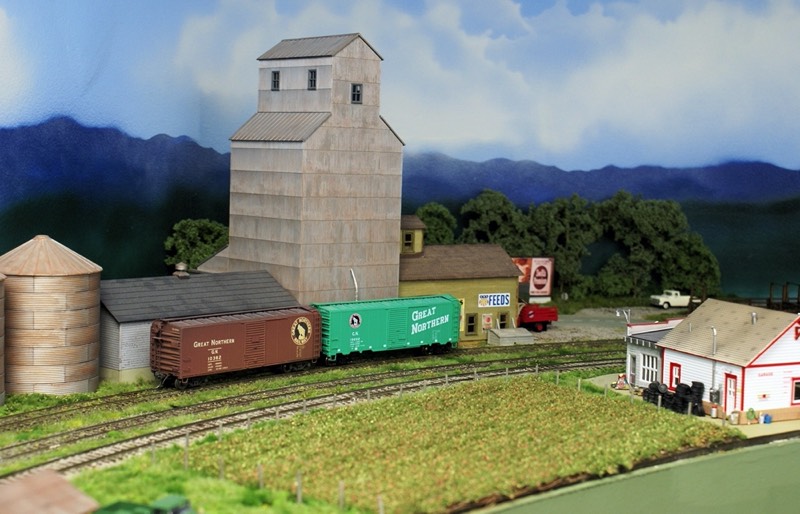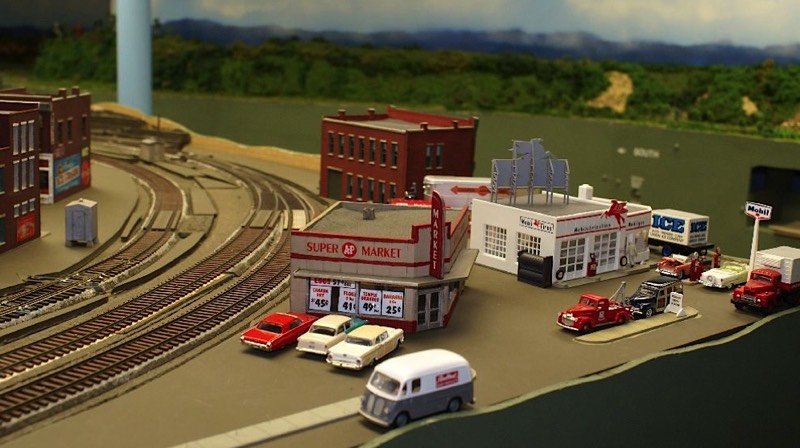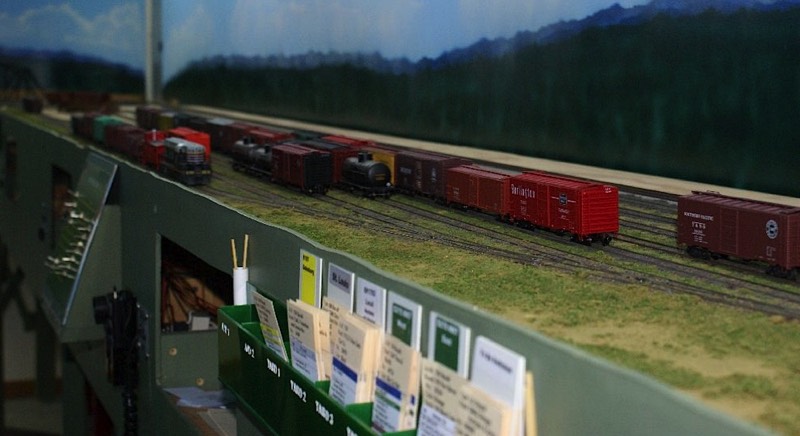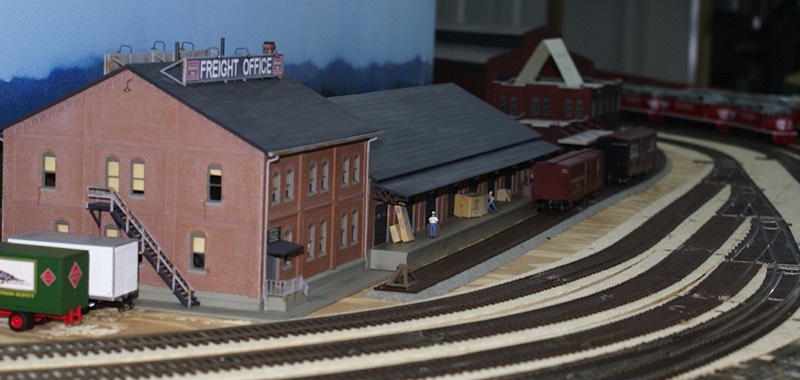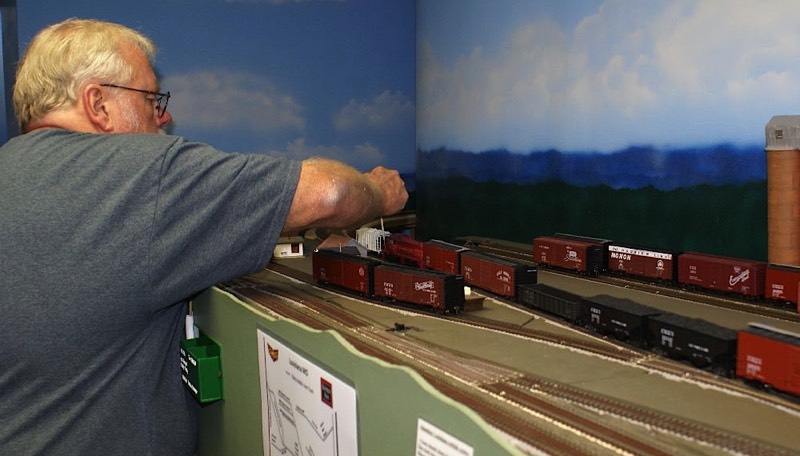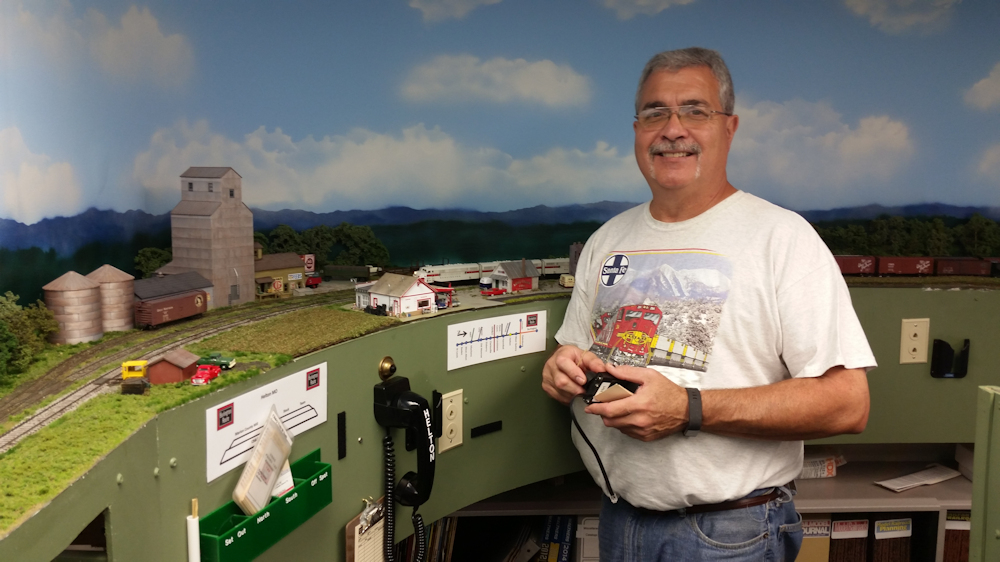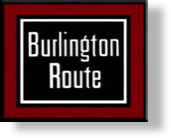
Bill Hirt’s Chicago, Burlington &Quincy, Hannibal Division


click to embiggen
About the Layout
The Burlington's K Line from St. Louis to West Quincy, Missouri, in late summer 1963. The MKT has trackage rights from St. Louis to Machens, Missouri. Interchange occurs with the Hannibal Connecting and Wabash at Hannibal, Missouri, the GM&O at Louisiana, Missouri, and the MKT at West Alton, Missouri.
Eighteen to 20 trains run in a session, including two passenger, two to three locals, an ore train, a coal train to Union Electric power plant at Machens, Missouri, and several through freights.
Eighteen to 20 trains run in a session, including two passenger, two to three locals, an ore train, a coal train to Union Electric power plant at Machens, Missouri, and several through freights.
Layout Accessibility Information

Entrance to the layout is through a walk out basement door.
There is a slight hill down to the walkout basement from the driveway. There is no sidewalk from the driveway to the walk out basement door. The entry door and the crew lounge are handicap accessible.
The remainder of the layout is not handicap accessible due to aisle width.
There is a slight hill down to the walkout basement from the driveway. There is no sidewalk from the driveway to the walk out basement door. The entry door and the crew lounge are handicap accessible.
The remainder of the layout is not handicap accessible due to aisle width.
Layout at a Glance

Layout at a glance
- HO
- Approx. 1700 sq ft. Eastern Missouri
- Walk around Main line run (length): 350 ft
- Height: Avg. 53 inches
- As of spring 2022: 90% sceniced between towns. Seven towns sceniced. One additional town 80% complete. Two Yards sceniced.
- Digitrax – tethered throttles for yard operators. Simplex radio throttles for road operators.
- Basement walk out
- Shenware car cards and waybills
- Number of operators – 13
Jobs on the Layout
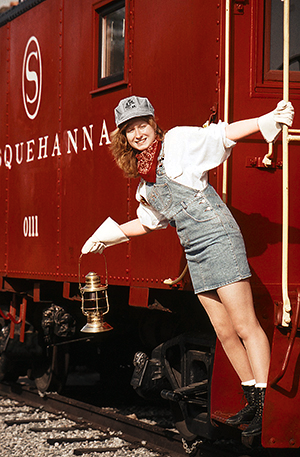
Jobs on the Layout
Dispatcher – uses phone system to dispatch. Verbal authority. Very basic timetable in use.
Hannibal Yard Master/Operator – Division Point yard. Very busy yard for the experienced yardmaster.
Hannibal helper/industrial switch job - assists the Hannibal YM and performs local switching
West Alton Yard Master/Operator – Moderately busy yard. All freight operations work this yard.
West Quincy Yard Master/Operator – Least busy yard with industrial switching duties.
The other eight operators run 18 to 20 trains run in a session including 2 passenger, 2-3 locals, ore train, coal train to power plant at Machens, Missouri, and through freights.
Hannibal Yard Master/Operator – Division Point yard. Very busy yard for the experienced yardmaster.
Hannibal helper/industrial switch job - assists the Hannibal YM and performs local switching
West Alton Yard Master/Operator – Moderately busy yard. All freight operations work this yard.
West Quincy Yard Master/Operator – Least busy yard with industrial switching duties.
The other eight operators run 18 to 20 trains run in a session including 2 passenger, 2-3 locals, ore train, coal train to power plant at Machens, Missouri, and through freights.
About the Layout Owner

About the Layout Owner
Bill has lived in the midwest all of his life with his formative years living near the CB&Q triple track mainline in the western Chicago suburbs. His junior high school had a model railroad club and with them he took his first trip to a hobby shop (Al's Hobby Shop in Elmhurst). His brother still has the Con Cor custom painted Athearn boxcar he bought that day.
After getting his work career established as a meteorologist with the National Weather Service, he returned to model railroading in the early 1990s. His current layout has been operational for over 20 years. Working on scenery and improving/building the various town structures are now the primary goals of future layout work. Much progress on scenery and structures has been made since Prairie Rail 2020.
After getting his work career established as a meteorologist with the National Weather Service, he returned to model railroading in the early 1990s. His current layout has been operational for over 20 years. Working on scenery and improving/building the various town structures are now the primary goals of future layout work. Much progress on scenery and structures has been made since Prairie Rail 2020.
Using Prototype Consists
Using Prototype Consists and Industrial Guides as an Operations Modeling Tool
by Bill Hirt
Researching actual operations and car movements on the CB&Q during my period of interest (1963 era) has become more and more interesting to me with time. I also have found that it makes creating model waybills more interesting and fun for me.
More and more excellent material has become available to those interested in this facet of the hobby. Russ Strodtz has posted on the Yahoo Rail Freight Group a number of CB&Q consists from switch lists and actual teletype printouts from the late 1950s into 1960s. Russ has also posted train consist information from the BN 1970s era. Others have posted consist information relevant to the areas they model.
The Great Northern historical society has some 1968 train consists listed on their web site. The same is true for the Northern Pacific society. I am sure there are more out there in the public domain that I am unaware of.
The NMRA Operations SIG has been a great source and collector of industrial information for modeling. OpSig founder Bill Jewett made this an initial focus of the group and collected contributions of industrial data from anyone who would provide it into a free database for use by the operations community. This can be accessed at: http://www.opsig.org/reso/inddb/
Ted Schnepf of Rails Unlimited has republished railroad industrial guides. I recently allowed Ted to copy a 1971 Rock Island Industrial Guide in my collection and he is now offering it for sale. He also has a 1962 Great Northern industrial guide for sale that is not listed on his web site.
There are also several industrial guides that have been posted on the web like a late 1950s Chicago Great Western and a mid 1950s Lackawanna.
There are also several blogs which have great prototype operations and waybill info. Two of my current favorites are Modeling the CNW in Milwaukee 1957 blog (http://cnwmodeling.blogspot.com/) and the Resin Car Works blog (http://blog.resincarworks.com/) mainly because they are about midwest modeling.
Tony Thompson’s Modeling the SP blog (http://modelingthesp.blogspot.com/) has had a number of posts to those interested in operations.
Combining the industrial guide and consist information, one can attempt to replicate some of the day to day car movements on the line you model.
Let us a look at the train consist CB&Q Train 97 Hannibal MO to West Quincy MO - 26-Aug-65 (PDF). We are back in the days when memory was lean on computers and memory space was expensive. Each car was represented by a key punched IBM 80 column computer card. This is best described by the files CBQ Car Reporting and IBM Car Records (PDF) and CB&Q Stations (PDF).
Using the two above sources, one can decode the actual consist. This is shown in the Excel file Train 97 Hannibal to West Quincy August 26 1965. Some information is not always obvious or lacking for a decode. For example, industry names could not be longer than 9 characters. I have observed this leads to some creative contractions with different clerks sometimes using different contractions for the same destination industry. Because industry guides seem to be lacking for many railroads after the early 1950s, this leads to some guesswork on some industries, consulting with friends who model or have interest in that line, or just using the industry contraction as is in a waybill due to the inability to determine the actual business name.
You can also spot some odd movements. In the Excel file Train 61 Galesburg to Hannibal mid or late 1966 there a number of ore loads headed to the Meramac Mining in Cadet Missouri on the Missouri Pacific. Meramac Mine opened around 1964 and produced very high grade iron ore. So the question was why would iron ore be shipped to an iron ore mine? Thanks to Paul De Luca and his fellow Union Pacific co-workers, they were able to find out for me from some former Missouri Pacific employees that these loaded cars were being brought in to help calibrate the output of the mine. So this was a very short-term move of cars into an industry that was primarily a shipper.
The Excel file Waybill Info is a summary of several consists and my research to create realistic waybills for my layout. I have tabbed it to show CB&Q gateways and online cars.
I have used Peter White’s Shenware Waybills program for many years now. I still use an older version of the Waybill program (6.03) because it allows me to have a larger industrial database (25,000 industries) and I am able to create Waybills to my liking. My current industrial database has been pruned to a little over 21,000 industries, but it still grows as I get more industrial and operations info. I’ve had some (including Peter) say that is overkill, but if you have 600 cars on your model railroad (and some here that are operating for Prairie Rail have nearly 1,000 cars), such a large database is not as far fetched as one would think (at least to me and a few others locally). Coming from a scientific background, more data is always preferable over less data.
Using Peter’s program one can create some rather complete Waybills. A sample sheet of car cards created from actual Waybills is available here (PDF).
I’ve been using this current set of Waybills for a year and I am still tweaking the railroad flow. I probably need to add a few more cars, but current operating sessions are going so smooth that it will likely just be a few cars at a time to keep from clogging up the yards and the railroad.
Researching actual operations and car movements on the CB&Q during my period of interest (1963 era) has become more and more interesting to me with time. I also have found that it makes creating model waybills more interesting and fun for me.
More and more excellent material has become available to those interested in this facet of the hobby. Russ Strodtz has posted on the Yahoo Rail Freight Group a number of CB&Q consists from switch lists and actual teletype printouts from the late 1950s into 1960s. Russ has also posted train consist information from the BN 1970s era. Others have posted consist information relevant to the areas they model.
The Great Northern historical society has some 1968 train consists listed on their web site. The same is true for the Northern Pacific society. I am sure there are more out there in the public domain that I am unaware of.
The NMRA Operations SIG has been a great source and collector of industrial information for modeling. OpSig founder Bill Jewett made this an initial focus of the group and collected contributions of industrial data from anyone who would provide it into a free database for use by the operations community. This can be accessed at: http://www.opsig.org/reso/inddb/
Ted Schnepf of Rails Unlimited
There are also several industrial guides that have been posted on the web like a late 1950s Chicago Great Western and a mid 1950s Lackawanna.
There are also several blogs which have great prototype operations and waybill info. Two of my current favorites are Modeling the CNW in Milwaukee 1957 blog (http://cnwmodeling.blogspot.com/) and the Resin Car Works blog (http://blog.resincarworks.com/) mainly because they are about midwest modeling.
Tony Thompson’s Modeling the SP blog (http://modelingthesp.blogspot.com/) has had a number of posts to those interested in operations.
Combining the industrial guide and consist information, one can attempt to replicate some of the day to day car movements on the line you model.
Let us a look at the train consist CB&Q Train 97 Hannibal MO to West Quincy MO - 26-Aug-65 (PDF). We are back in the days when memory was lean on computers and memory space was expensive. Each car was represented by a key punched IBM 80 column computer card. This is best described by the files CBQ Car Reporting and IBM Car Records (PDF) and CB&Q Stations (PDF).
Using the two above sources, one can decode the actual consist. This is shown in the Excel file Train 97 Hannibal to West Quincy August 26 1965. Some information is not always obvious or lacking for a decode. For example, industry names could not be longer than 9 characters. I have observed this leads to some creative contractions with different clerks sometimes using different contractions for the same destination industry. Because industry guides seem to be lacking for many railroads after the early 1950s, this leads to some guesswork on some industries, consulting with friends who model or have interest in that line, or just using the industry contraction as is in a waybill due to the inability to determine the actual business name.
You can also spot some odd movements. In the Excel file Train 61 Galesburg to Hannibal mid or late 1966 there a number of ore loads headed to the Meramac Mining in Cadet Missouri on the Missouri Pacific. Meramac Mine opened around 1964 and produced very high grade iron ore. So the question was why would iron ore be shipped to an iron ore mine? Thanks to Paul De Luca and his fellow Union Pacific co-workers, they were able to find out for me from some former Missouri Pacific employees that these loaded cars were being brought in to help calibrate the output of the mine. So this was a very short-term move of cars into an industry that was primarily a shipper.
The Excel file Waybill Info is a summary of several consists and my research to create realistic waybills for my layout. I have tabbed it to show CB&Q gateways and online cars.
I have used Peter White’s Shenware Waybills program for many years now. I still use an older version of the Waybill program (6.03) because it allows me to have a larger industrial database (25,000 industries) and I am able to create Waybills to my liking. My current industrial database has been pruned to a little over 21,000 industries, but it still grows as I get more industrial and operations info. I’ve had some (including Peter) say that is overkill, but if you have 600 cars on your model railroad (and some here that are operating for Prairie Rail have nearly 1,000 cars), such a large database is not as far fetched as one would think (at least to me and a few others locally). Coming from a scientific background, more data is always preferable over less data.
Using Peter’s program one can create some rather complete Waybills. A sample sheet of car cards created from actual Waybills is available here (PDF).
I’ve been using this current set of Waybills for a year and I am still tweaking the railroad flow. I probably need to add a few more cars, but current operating sessions are going so smooth that it will likely just be a few cars at a time to keep from clogging up the yards and the railroad.
History of the K-Line
History of the K-Line
Hannibal, Missouri, famous as the birthplace of Samuel Clemens, aka Mark Twain, also has a rich heritage as a railroad town and a long history with the CB&Q. The Hannibal and St. Joseph Railroad, chartered in 1852, began in Hannibal and became the first railroad to stretch across lhe stale to the Missouri River at St. Joseph in 1860. The first Railway Post Office car traversed the Hannibal and St. Joseph, passing mail to the Pony Express during its short existence in 1861 and 1862.
The Hannibal and St. Joseph went in and out of control of the Burlington until the late 1880's, when it was fin ally purchased by the CB&Q from Jay Gould and Wabash interests. This firmly established Hannibal as a division point and location of repair shops.
The Hannibal and St. Joseph went in and out of control of the Burlington until the late 1880's, when it was fin ally purchased by the CB&Q from Jay Gould and Wabash interests. This firmly established Hannibal as a division point and location of repair shops.


The K-Line in 1905
In 1900, the CB&Q's board of directors began looking for a way to shorten the track distance between Kansas City and St. Louis. In 1903, CB&Q began construction of a branch from Old Monroe, MO, (about 50 mi les north of St. Louis) to a connection with the Chicago and Alton at Francis, MO. The CB&Q then negotiated trackage rights over the Alton to Kansas City and immediately started freight and passenger service over the new route. This new route saved 68 miles over the previous circuitous route via Hannibal.
Following World War II several changes to the operation of the K-Line came about. The Gulf Mobile & Ohio (GM&O) purchased the Chicago and Alton and a new operating agreement was quickly negotiated with the GM&O. The CB&Q had attempted to purchase the GM&O line across Missouri (and share control with the Santa Fe) as a condition of the Alton's purchase. However, opposition from many of the St. Louis based railroads (many of them in receivership) resulted in the ICC denying the petition. With the denial of the petition, the Burlington discontinued passenger service on the route. However, a new agreement with the GM&O allowed freight service to be totally handled by CB&Q crews and equipment for the entire St. Louis-Kansas City route.


The K-Line in 1963
New yard and station facilities were built at West Quincy, MO, in the early 1950's. This helped eliminate an inefficient backing move for passenger tra ins across the Mississippi River into Quincy, IL. At the same time, a new depot was built at Hannibal , replacing the Union Depot shared with the Wabash. The arrival of GP7's in 1951-1952 banished most of the steam power from the line. The line was completely dieselized by the mid-1950's.
In 1970, the CB&Q along with the Northern Pacific Railway Co. (NP); Great Northern Railway Co. (GN); and the Spokane, Portland and Seattle Railway Co. (SP&S) were all combined to form the Burlington Northern Railroad, which in later years would acquire the St. Louis San Francisco and the Atcheson Topeka and Santa Fe to become today’s Burlington Northern Santa Fe Railroad.
~ Bill Hirt, published in the Layout Design Journal #31, December 2004
Photo Gallery
(Click to embiggen)























